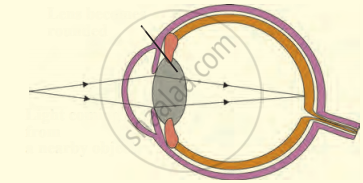Advertisements
Advertisements
Question
The thin, transparent extension of sclerotic layer found in front of the lens is ______.
Options
Cornea
Cochlea
Conjunctiva
Choroid
Solution
The thin, transparent extension of sclerotic layer found in front of the lens is Cornea.
RELATED QUESTIONS
Explain why the image distance in the eye does not change when we change the distance of an object from the eye?
Match the following:
| Column I | Column II |
| (i) Myopia | (a) Converging power of eye lens becomes low |
| (ii) Hypermetropia | (b) Converging power of eye lens remains the same |
| (c) Converging power of eye lens becomes high |
Name the part of the eye:
which changes the focal length of eye-lens.
What is the:
far point of a normal human eye?
Name the part of our eyes which helps us to focus near and distant objects in quick succession.
Why does it take some time to see objects in a dim room when you enter the room from bright sunshine outside?
Which of the following have a wider field of view?
(a) Animals having two eyes on the opposite sides of their head.
(b) Animals having two eyes at the front of their head.
State whether the following statement is true or false:
Rabbit has eyes which look sideways.
Among animals, the predators (like lions) have their eyes facing forward at the front of their heads, whereas the animals of prey (like rabbit) usually have eyes at the sides of their head. Why is this so?
Differentiate between members of the following pair with reference to what is asked in bracket.
Rod and cone cells (pigment contained)
Mention if the following statement is true (T) or false (F) Give reason.
Sometimes medicines dropped into the eyes come into the nose and even throat
Define the following:
Blind spot
What happens to the image distance in the normal human eye when we decrease the distance of an object, say 10 m to 1 m? Justify your answer.
Long answer question
Draw the neat labelled diagram of the Sectional view of the human eye.
Name the capacity of the eye lens to change its focal length as per need.
The following figure show the change in the shape of the lens while seeing distant and nearby objects. Complete the figures by correctly labelling the diagram.

Shylesh is a school-going kid studying standard VIII. He is crazy about playing video games on mobile phones. After a couple of months, his eyes turned red and he felt severe pain in his eyes. His science teacher enquired about this and advised his parents to take him to an eye doctor.
- How does excessive usage of mobile phone affect our eyes?
- What are the values shown by the teacher?
When light rays enter the eye, most of the refraction occurs at the ____________.
In human eye the part which allows light to enter into the eye is ______.
Match the following:
|
Column - I |
Column - II | ||
| 1 | Retina | a | Path way of light |
| 2 | Pupil | b |
far point comes closer |
| 3 | Ciliary muscles | c |
near point moves away |
| 4 | Myopia | d | Screen of the eye |
| 5 | Hypermetropia | e | Power of accommodation |
